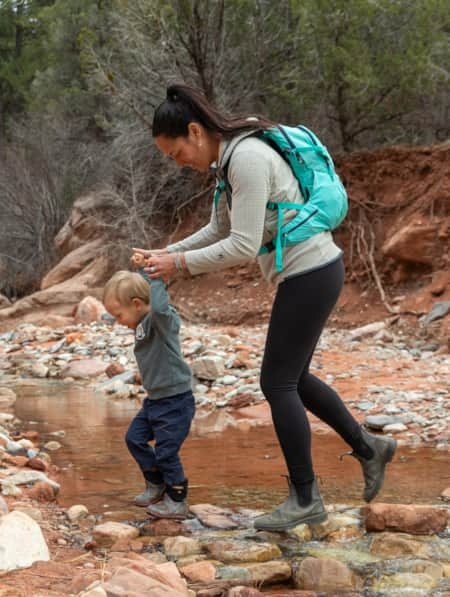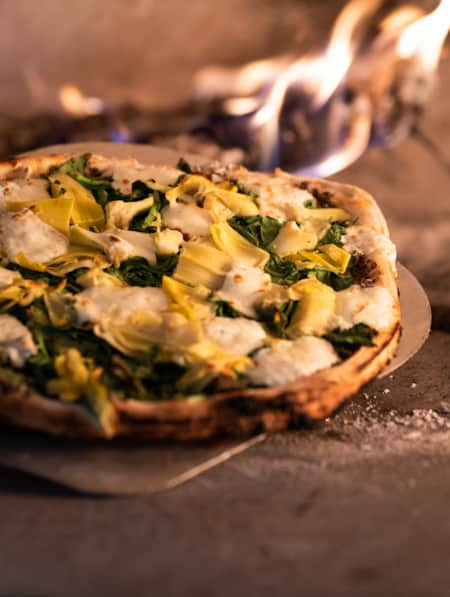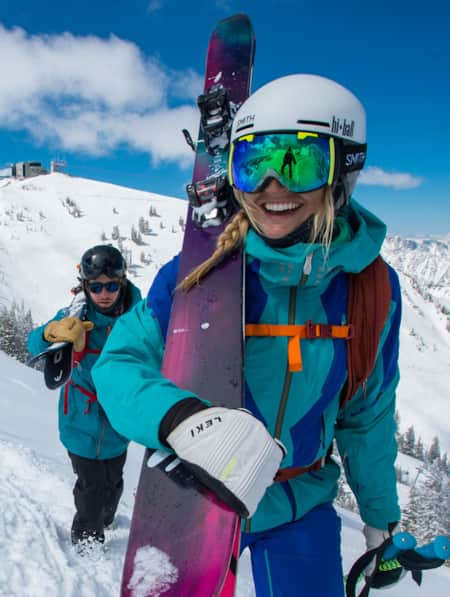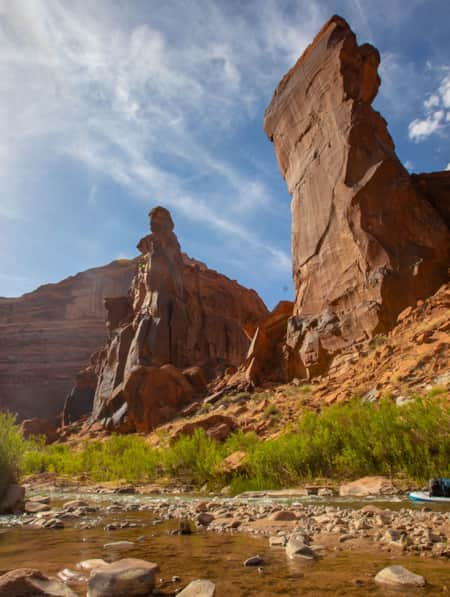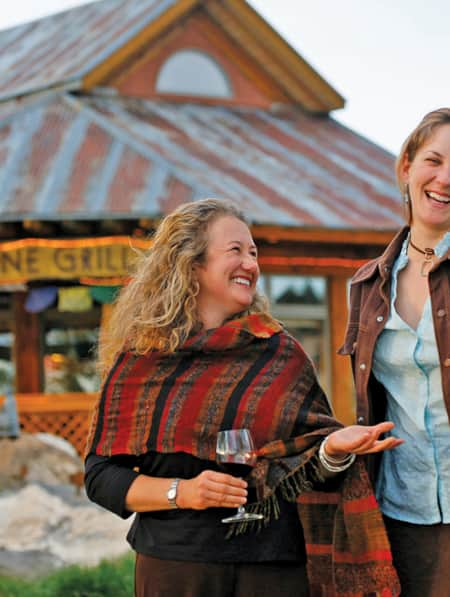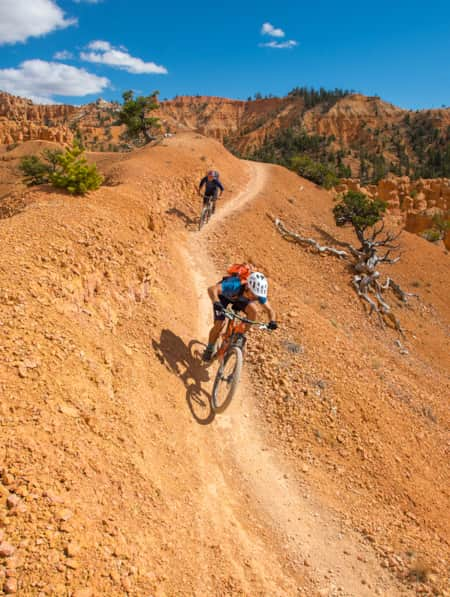Larger Than Life: Winter in Southwestern Utah
This desert is dramatic. In a really good way. Experience the towering heights of Zion, the depths of Buckskin Gulch, the dunes of Snow Canyon, the sunset over Gooseberry. Southern Utah’s wilds are wearing their winter splendor.
The southernmost wilds of Utah are known for going big. Really big. From Zion National Park’s soaring 2,000-foot sandstone cliffs to Buckskin Gulch, the longest slot canyon in the country, these lands awe and inspire at every turn.
This journey will take you mountain biking on a sky-high red rock mesa, hiking some of Zion’s most iconic trails, strolling the soft warm sand of the Coral Pink Dunes, exploring an animal sanctuary where you can (and will) give a rescue pig a back-scratch, and finally wandering some of the state’s most dramatic slot canyons.Our itinerary shares a sampling of highlights in this area, but there’s enough to spend a lifetime exploring. So if you can carve out any extra days to spend on this trip, take the time to go deeper into the rocky wonderland between Zion and Kanab.
(Read: Take Advantage of Southern Utah’s Off-Season with Winter Glamping)
Start: Salt Lake City (you can also fly into Las Vegas for a shorter drive to your day-one destination)
Finish: Kanab
Hours of drive time: 12-14 depending on starting point

Get up Close and Radical With Southern Utah’s Slickrock at Gooseberry Mesa
296 Miles
Mileage: 296 (from Salt Lake) or 142 (from Las Vegas)
Just outside the colossal rock formations of Zion National Park lies Gooseberry Mesa, a destination its own right. This incredible mesa plateau bears a rockscape straight out of Mars — or, if you ask mountain bikers — heaven (Read: Winter Mountain Biking in Southern Utah). Gooseberry is well worth spending a day or more to explore. The plateau is laced with world-class mountain biking trails on a natural roller-coaster slickrock surface, which overlooks the desert valley below.
If you already have some mountain biking skill, you can bring your own or rent a bike in the nearby town of Hurricane. Or, if you’d like, local guide services can help outfit you and lead you through a few trail rides together — a wonderful idea if you’re newer to biking. Keep in mind that most of the trails here are intermediate or advanced. If you’re a newbie to mountain biking, steer clear of the advanced trails, aim for something easier like Goosebump Loop or White Trail, and don’t hesitate to walk your bike if the trail section looks intimidating. Daytime winter temperatures average in the 50s and 60s, which is perfect for cool-weather cardio. (Read: Winter in Southern Utah Like a Local)
You can also simply hike or jog the trails instead of biking them, and still enjoy all the same views — just keep an eye out for bikers and step aside so they can pass by, and if you have a dog, keep him or her on leash.
We highly recommend the locally owned Gooseberry Yurts for a winter-approved camping experience, as the huts are cozily equipped with wood-fired stoves and cushy bunks. (Check out their gear-packing list and bring your own food, which you can pick up in Hurricane.) Whatever you’re doing around 6 p.m., it’s not as important as watching the sunset from the mesa. Plan accordingly.
Where to Stay
Gooseberry Yurts or in Hurricane, UT
Tips for Prepared Travel
Gooseberry Mesa is an adventurous place (Read: Mission to Mars: Riding Gooseberry Mesa). Do your research on trails ahead of time, the MTB Project is also a wonderful resource. And reserve your lodging ahead of time, especially if it’s one of the yurts. Call local bike shops ahead of time to confirm bike availability if you need to rent one, and don’t hesitate to ask them for guiding services if you’re not a seasoned biker.
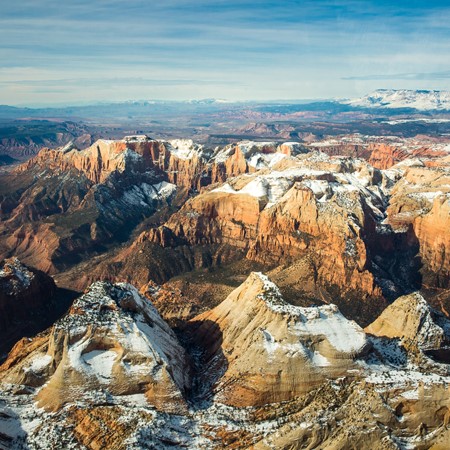
Behold Zion National Park in Its Silent Winter Glory
50 Miles
- Hike Scout Lookout, conditions permitting
- Explore the Emerald Pools
- Stroll the Riverside Walkway
- Hike the Zion East Rim Trail
Winter is the ticket to a peaceful experience visiting Zion National Park, as you can ditch the crowds and the shuttle lines. (And skip the blazing summertime temps.) Local wildlife is out in abundance, and you’re even allowed to drive to all the park’s trailheads (as opposed to summer, when crowd levels make shuttles mandatory).
Take a hike to Scout Lookout, carefully avoiding any icy trails or sections. Scout Lookout gets you within a stone’s throw of the famed Angel’s Landing pinnacle, minus the final section, which is more dangerous to hike in winter. If the hike is too icy or dicey, don’t sweat it. Check out the Zion East Rim Trail instead. The East Rim trail is a long, winding trail that connects the park’s east entrance to the main Zion Canyon. While it’s long (over 10 miles) there’s no need to hike the entire thing if you don’t have time. Get a taste, and you’ll be glad you did.
Wrap the day with a close-up look at the Virgin River and the famous Zion Narrows on the Riverside Walkway. The Narrows are a refreshing hike in the summer, but you probably won’t be in the mood to get wet in the winter, so just observe from the dry shore. If you’re feeling adventurous and want to venture upstream, you can arrange the hike with a local guide and outfitter service and do it in a drysuit so it’s comfortable.
Where to Stay
Springdale or the east side of Zion National Park (such as Zion Ponderosa Ranch)
Tips for Travel
Temperatures in Zion vary wildly based on whether you’re in the sun or in the shadow of the park’s deep canyon walls. Bring more layers than you’ll expect, plus boot traction cleats and trekking poles in case the paths get icy or snowy. Never ever attempt a steep or exposed trail if the surface is slick (Read: Winter in Zion).

Petrified Sand Dunes, Desert Art, and a Glimpse at Pioneer History
50 Miles
- Wander Snow Canyon State Park
- Explore Red Cliffs Desert Reserve
- Wander the Kayenta Artist’s Village
- Visit Brigham Young Winter Home historical site
Descend from the sky-high canyon walls of Zion to the sunny St. George area, where temperatures hover around the mid-50s in mid-winter. One of the best ways to get to know St. George is to venture into Snow Canyon State Park, which lies within the greater Red Cliffs Desert Reserve, and is a gem amid a gorgeous landscape. There are several exceptional hiking trails and paths, plus a long, paved bike path. The Petrified Sand Dunes are a favorite winter walk, with sweeping views of the greater canyon surrounding you.
Around mid-day, check out the southwestern and Native American art galleries in nearby Kayenta Village, which doubles as an excellent lunch spot. You can also reserve a golf tee time if that’s your cup of tea. With its mild weather, St. George is a beloved golf destination for Utahns, who come down from Salt Lake in the cooler months to enjoy a few rounds. (By contrast, this area spikes well above 100 degrees Fahrenheit for much of the summer, so this is the time to enjoy it.)
For a taste of local settlers’ history, tour the Brigham Young Winter Home historical site. It will give you a feel of what drew the area’s early pioneer settlers and how they set up homesteads in a place that’s piping-hot for so much of the year.
Where to Stay
St. George
Tips for Travel
The St. George area is a bustling hub for travelers, retirees and college students alike. That makes the town an excellent place to fuel up, stock up, and even enjoy one of the best Indian food meals of your life at Red Fort restaurant.

From Coral Sand Dunes to Rescue Animal Snuggles: the Journey to Kanab
80 Miles
- Somersault on the sand at the Coral Pink Sand Dunes State Park
- Visit the animals at Best Friends Animal Sanctuary
- Finish your day with a comfort-food meal in Kanab
You may have experienced Gooseberry, Zion and Snow Canyon in the last few days, but there’s even more excitement ahead as you head toward the wilds of Kanab country. With its “classic Western” landscape, the Kanab area is famous as the setting of countless old Western films and TV shows, from “How the West Was Won” to “The Lone Ranger” and even “Arabian Nights.” You can get to know the area’s filmmaking history at Kanab’s very own Little Hollywood Movie Museum, right in the middle of town.
This day’s itinerary is about the journey to Kanab — taking in the one-of-a-kind scenery that surrounds the area. You’ll stop at the Coral Pink Sand Dunes State Park, a mere 20-minute jaunt off the highway. It’s well worth a stop for beautiful midwinter photographs of the pink sand dunes against the blue desert sky, and if you have kids, they can get infinite wiggles out by somersaulting and rolling down the dunes.
You’ll top the afternoon off with a visit to Best Friends Animal Sanctuary, a world-famous animal sanctuary for dogs, cats, horses, pigs, birds, rabbits and more. You can take a tour, meet and greet a few animals, or even pre-arrange to volunteer for the day. They offer a number of educational programs, lodging and the finest vegan lunch buffet you ever did see. Finish your day in a cozy hotel room in Kanab, ideally grabbing a healthy meal at Rocking V Cafe. This meal should end with pie.
Where to Stay
Kanab
Tips for Travel
As you’re descending to lower elevations, the temperatures warm up. But you’ll still want to pack plenty of layers for hiking, and keep snow-boot spikes in your pack in case they can help your footing on snowy or icy paths in the shade.
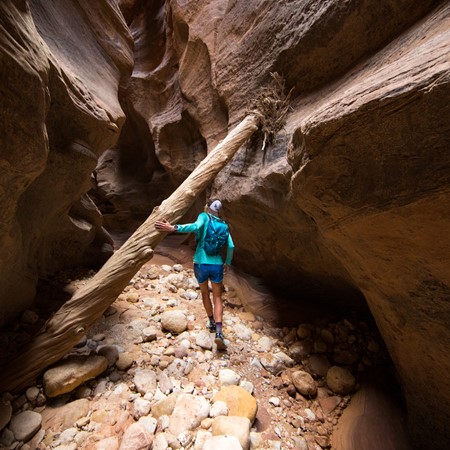
Hit the Slots Around Kanab
108 Miles
Wake up nice and early: the most famous hike in the Kanab area is called The Wave, and it’s legendary for good reason — the sculpted rock formations here are absolutely unreal. Since it’s so special, a hiking permit is required. Permits are limited and are issued by the Bureau of Land Management via a lottery system.
If you don’t make it to The Wave, your consolation prize is still one of the most gorgeous hikes on the planet — Buckskin Gulch, one of the longest and deepest slot canyons in the world. It’s long enough to be a multi-day backpacking trip, but don’t sweat it if you only have time to go a few miles. That still gives you a good taste. The easiest access to Buckskin Gulch is via the Wire Pass trailhead on House Rock Valley Road, which is best navigated in a four-wheel-drive vehicle. You can also access it via the official Buckskin Gulch trailhead four miles earlier on the same road, but this involves a few miles of uneventful overland walking in a desert wash before you get to the main event, the gulch itself.
If you still have any time free, drive to White House Trailhead and take a brief walk up the river wash in the meandering Paria River canyon. It’s easy to access and the riverbed is delightful for taking a walk. Just keep in mind that the trail goes in and out of the shin-deep water, and winter temps will chill your feet quickly, so this is best approached as a short walk.
Where to Stay
Kanab
Tips for Travel
This day’s itinerary includes slot canyons, which are wonderful but incredibly dangerous places to be if there’s any rain in the forecast or rain nearby. Flash floods here are deadly. If you have any question about whether it’s a safe day to venture into a slot, just ask the local visitor’s center rangers. They’ll be up to speed.



